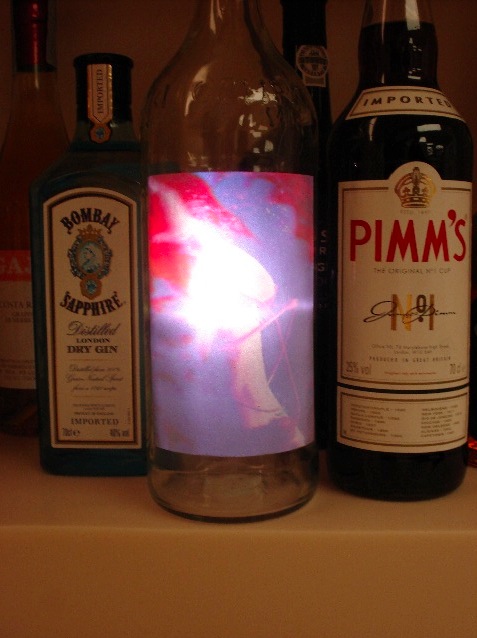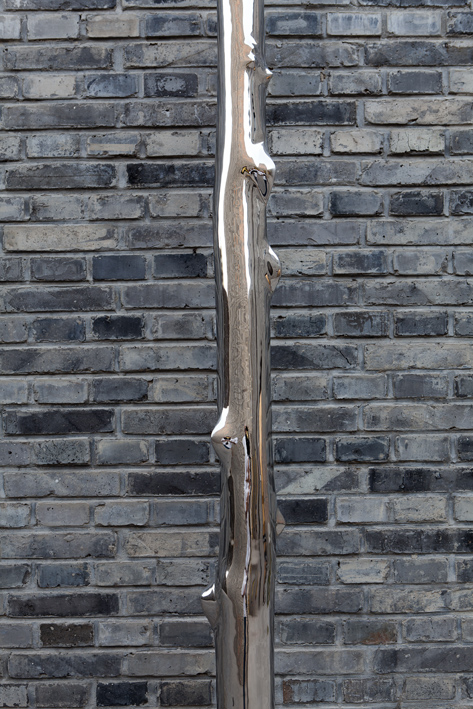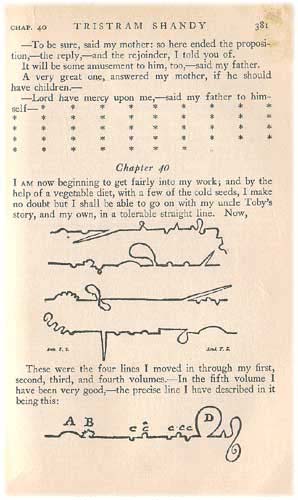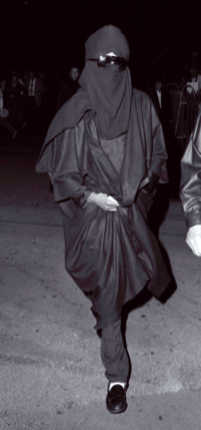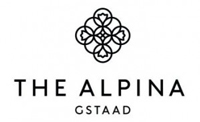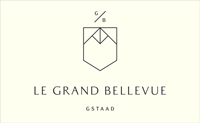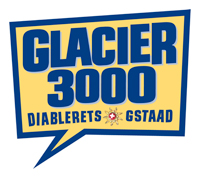
































Latest News
























Roman Signer talks to Ewa Hess about „Alles fährt Ski“ (Everything Skies)
© SonntagsZeitung
Roman Signer, do you like the music of Trio Eugster?
You mean because of the title “Alles fährt Ski”? I didn’t even know it was their song.
Was seventies Schlager music the inspiration for your new work?
(Singing:) “Alles fahrt Schii, alles fahrt Schii, Schii fahrt die ganzi Nation. D Mamme, dr Bappe, dr Sohn. Es git halt nüt Schöners, juhe, juhe, als Sunneschy, Bärge und Schnee ... (laughing). No, the point of departure wasn’t the song, but the idea of a cabin on skis, going down the slope. It wasn’t until later that the song we sang came to mind. We play it on the speakers as the cabin is skiing down the mountain.
How does a cabin even ski?
Just like people; we place it on skis. We’d probably place four pairs underneath it. And the light will be on, as if a family were sitting at the table eating fondue while the cabin is gliding down. “Alles fährt Ski” (Everything Skies) indeed, and now in Gstaad even the chalets do!
But wouldn’t the cabin collapse?
No, we’ll see to it that it doesn’t. It’s also meant to remain next to the slope after it skies down, until March. We will film the whole thing, and then screen the video inside the cabin.
It sounds funny, but letting a cabin ski down a slope is a rather rakish idea.
Yes, it is. We have to take precautions to ensure no one gets hurt.
What for example?
We’ll do test runs. We’d let the cabin glide down a third of the mountain slope first and see how it holds up. Then we’ll pull it back up and try half of the slope. We also need to make sure it doesn’t just go all day way down into the parking lot.
How heavy is it?
It weighs half a ton. It’s a small cabin, three by five meters and three meters high. Just big enough for a family to sit around a table inside. We’ve just visited a Chalet maker in Gstaad, Albert Bach, who’s constructing your cabin as requested. He was astonished about the peaked roof.
Why do you want it to be so steep?
I’m used to roofs with a 43° slant, that’s how they’re built in the east of Switzerland. Here, on the other hand, they make cabins with somewhat less slanted roofs, about 30° only. The chalet maker noticed the disparity, but I’m going to stick to my version. That’s how I like it.
A plucky East Swiss gets his way in the Bernese Oberland?
Sure, why not? We let Simmental cattle pasture in the east, so our pointed gable should be allowed to enjoy some local hospitality, too. And anyway, it’s only temporary, until March.
Aren’t you worried that the steel cable that the cabin is attached to and that you’re supposed to cut will snap back and injure you?
I’m not worried about myself at all, only about the viewers. A certain amount of tension should always be at play; it’s a part of it.
The chalet maker suggested the cabin be glided down a cable, and brakes be built in. but you don’t want that.
No, not like that. I had other ideas. One could attach an anchor to the cabin for example, or a rubber band that would bounce it back uphill (laughs). Or maybe self-demolition activation at the end? This way it doesn’t make it too far down the slope (laughs harder). But that would be too dangerous.
Do such ideas just pour out of you in everyday situations too? Do you see everything in motion or exploding?
No, but you see very interesting things in everyday life. I was in Iceland once, for an exhibition, and as I was looking for the keys to my accommodation, a huge heap of snow slid off the roof and fell right in front of me. Had I been standing one step closer to the door, I would have been buried underneath it. The key saved my life.
Danger is as present in the everyday as it is in your art?
Everyday life is the most dangerous thing there is. Snow or a melting icicle can kill you; you could fall off a ladder. Death is always lurking.
Like what’s happening now with Michael Schumacher.
Exactly! All those races, all the accidents he had survived and suddenly, this stroke of fate.
Do you think about that a lot?
Certainly. There are dark forces at play here.
Your art is often urged by your playing with the fundamental forces of nature. Is this what makes your work so fascinating?
Could be. People live with danger without paying attention to it. In Utrecht, in the Netherlands, I once saw how a huge branch fell from a tree right behind a cyclist. The cyclist just dashed on, didn’t even notice it.
Do you sometimes test your luck with your action performances?
I don’t always do action performances. I will be showing sculptures in an upcoming show at Hauser & Wirth Gallery in Zurich. And in general, I’m doing a lot less action performances than before. They’ve also become less dangerous. The one where I’m walking on thin ice, at the risk that it might crack; I wouldn’t do that today for example.
Too risky?
One shouldn’t challenge fate twice the same way.
Your installation here in Gstaad is shown as part of “Elevation 1049”. Were you immediately in favor of the idea of doing an Alpine Biennale?
What’s happening here is quite crazy! I marvel at the organizational challenge alone. I like Gstaad, I prefer it to St. Moritz. It’s “cozier”.
Gstaad is also very chic, and this glamorous art event will make it even more posh. Doesn’t that bother you?
No, I’m happy if there’s more appreciation for contemporary art in Simmental. Coming from Appenzell, I’m happy that, thanks to the Liner-Museum and the Kunsthalle Ziegelhütte, not only decorative painting is considered art anymore.
Are you currently working on other projects?
I have a show in the St. Gallen Art museum in June – a “home match” so to say. And then there might be a show in China.
Have you ever exhibited in China before?
Yes, I once did something really crazy for the Shanghai Biennale. It was a huge wooden ball, about 1 meter in diameter and filled with blue paint, which was let go from 35-meter height. It was a fantastic fall.
You are a highly esteemed artist in Japan; is the appreciation for you work as big in China too?
I think the Japanese might understand my work better. In Japan, there’s more appreciation for minimalism and reduction. Chinese culture is more “Baroque”.
What is your favorite place to exhibit?
Clearly in Switzerland. But also France, England and Holland.
Published 12.1.2014 / © SonntagsZeitung
Translation by Hili Perlson

Gianni Motti, Levitation, 1995
Performance in collaboration with Mister RG
Courtesy Galerie Perrotin, Paris
"Mürrischer Schnee" in Gstaad is the first work I am making with the material "snow". It makes me happy since I grew up and lived until I was twenty years old in Davos, which has a lot of snow in winter as well. "Mürrischer Schnee" is a sculpture with real and fake snow. Snow is not different than any other precarious material and therefore it belongs to the vocabulary of materials I love to work with. Snow, like tape, styrofoam, cardboard, photocopy, or plastic is just a material.
"Mürrischer Schnee" is a little town with different constructions, 'homes' or shelters. In this landscape of risks the 'homes' are refuges for Reality - this is the affirmation, this is my affirmation. The meaning is: Reality gives shelter, Reality is the refugium! The shelter is not an escape from Reality – but just the opposite - it’s a Refuge to face and confront Reality. "Mürrischer Schnee" is a shelter for Reality, not from Reality. Indeed, instead of 'dreaming', instead of escaping and turning my back to Realiy, the only way to confront the time I am living in, is to embrace Reality. To embrace it – decidedly and dedicated - as a way of accepting the infight with our World, the only and unique World – the World I am part of. I do think Art can give a Form to this infight. The little town constructed with and in the snow is emblematic for understanding that our last refuge is Reality – today – with all its risks.
Snow is 'mürrisch' as it can be ‘joyful’. ‘Mürrisch’ means grumpy but also cantankerous, crotchety, or liverish. Being 'mürrisch' reflects the necessity of understanding snow as an uncontrollable and unstabilized material, as something that cannot be neutralized, as something reaching beyond human imagination, something refusing domestication and something impure. To give Form to the landscape of Risk as a shelter is a “mürrischer” act and things must therefore perform beyond glamour and fashion. The material “snow” is - like other materials I use to make sculpture - precarious, uncertain and without guarantee. I do not want to try to dominate or 'manipulate' Snow in a sophisticated way, I understand snow as a material of resistance as such. Snow - in remaining 'mürrisch' - resists the temptation to escape Reality. “Mürrischer Schnee” resists the idea of snow as a support only for pleasure and as a surface for the privileged.
"Mürrischer Schnee" in Gstaad is realized in an accessible, unspectacular and everyday location. The location at ‘Moos’ in Lauenen is an universal, inclusive spot. A location which wants to reach a non-exclusive audience - even in such a resort as Gstaad, which can be exclusive and selective. I want to carry with me my own universal vision of “snow” from the time spend in snow in my hometown Davos and the time spend in making Art.
Thomas Hirschhorn, January, 2014
‘Domingo’ is a collaboration between Bernhard Hegglin and me. What we were trying to do, is to generate an object, where one could find both our work, or personalities, united, as a little homage to the times we shared a studio. It was when I was working on a series of paintings, with the logo of ‘The Grateful Dead’, printed on them. Bernhard's typical pose during that time, was to lie around in one of those aluminum deck chairs. It began with a joke: We stapled the left over bears, that took away space in our studio, onto the empty frame of the deck chair, after the original lining was broken, because of wastage. Soon we realized, that there was a certain charm to the object we had generated. We started to think about the deck chair a little more.
A deck chair is often associated with leisure time and relaxation. The specific aluminum frame we use for our model is not the typical wooden framed deck chair, one would find next to a pool side, a beach, or on an ocean cruiser- it is more close to a camp bed. As every deck chair, it is transportable and stackable, although notoriously difficult to fold and unfold. That is where its natural sense for comedy finds its spot in the object.
The combination with the 'Grateful Dead' logo bear, (a happily smiling, yet slightly creepy image of a marching bear), turns the object into something a little absurd, for there is a certain possibility for an analogy to a merchandise item.
With its new, rather stiff lining, one can obviously not sit in the deck chair. We wanted to re-contextualize the deck chair and transform it into a work of art. Putting the specific object, (a singular piece and not a serial production) on a pedestal, underlines the fact, that it is an art work, namely a sculpture.

Matthias Brunner began his career as movie buff, critic, film producer and film curator for art house movies in Switzerland. He has collaborated with many film festivals including Filmex and the American Cinematheque in Los Angeles, the Locarno Film Festival, and Zürich Film Festival.
Brunner has been attending all major film festivals for the past 40 years. In 1992 he became a film curator for Art Basel and a member of the European Film Academy. He is founder and manager of the Douglas Sirk Foundation and recently co-produced “Sennentuntschi“ and “Paul Bowles – The Cagedoor Is Always Open“.
His first art/film installation, „Magnificent Obsession – The Love Affair Between Movies And Literature“, was shown on the Monte Verita and is currently in the collection of the Kunsthaus Zürich and “La Maison Pour L’ecriture Et La Litterature“. His latest installation „The Magic World Of The Mountains In The Films By Daniel Schmid“ was exhibited in 2013 at the Chesa Planta Museum in the Engadin. He has received several awards for his work in the field of arthouse movies such as the 1st award from Europa Cinemas, Strassbourg, the Zürich Film Award and a decoration as „Officier Des Arts Et Des Lettres“ from the State of France.
Urs Fischer and various artists, YES, 2011–
Unfired clay sculptures modeled on-site by multiple authors
Dimensions variable
© Urs Fischer. Courtesy of the artists.
References:
www.smashits.com/bollywood-s-love-for-switzerland/bollywood-gossip-1681.html#Fdw6eXCpcul4EmQd.99
www.nytimes.com/2010/07/12/world/europe/12swiss.html
online.wsj.com/news/articles/SB10001424...
entertainment.oneindia.in/bollywood/features/2012/yash-chopra-romantic-place-switzerland-101111.html
It’s unknown if stones, like people, have sonic memories. Stones, like sculptures, and sometimes people, are silent, unless instigated.
Hannah Weinberger’s ‘Untitled’ (2013) is a series of large boulders, quarried from a rock face in Switzerland. Released from their natural environment by violent mechanical means, these stones have been transformed into resonating speakers that eschew conventional understandings of audio equipment. Not reduced to the functional role of amplifying, these speakers act as live instruments.
Sound waves ricochet between magnets set in each stone’s hollowed interior, coaxing out the stone’s latent timbres conjoined with Weinberger’s compositions. Discrete configurations of field recordings, pop song snippets, and found sound bytes dragged and dropped into dense, hypnotic ambient loops timed to a conventional 20th century song’s 4x4 meter stimulate each stone’s individual tactile qualities. The hard and rigid material of the stones contrasts with the compositions’ ambient tonal curves to engender an elaborated soundscape, inseparable from its sculptural presence.
Louenesee Lyrics:
I weiss no guet, wo i är Sunnä bi gsässä. Wit äwäg vom Lärm vo dr Stadt. I weiss no guet, wie i ha chönnä vergässä, dert hindä bim Louenesee.
S'het mi packt, i ha gspürt das i gah mues, eifach furt id Rueh vor Natur. Ganz älei mit äm Chopf voll Gedankä, dert hindä bim Louenesee.
Immer wenn i wider dra dänkä, a das Gfüeu denn am Ufer vom See. De merki wie guet dass mir ta het, i gloubä i gangä no meh, ä Louenesee.
I weiss no guet, wo i är Sunnä bi gsässä. Wit äwäg vom Lärm vo dr Stadt. I weiss no guet, wie i ha chönnä vergässä, dert hindä bim Louenesee.
Immer wenn i wider dra dänkä, a das Gfüeu denn am Ufer vom See. De merki wie guet dass mir ta het, i gloubä i gangä no meh, ä Louenesee, ja i gangä no meh, ä Louenesee, ä Louenesee, ä Louenesee, i gangä no meh, ä Louenesee.
Swiss artist Urs Fischer talks to curator Neville Wakefield about art and identity
Neville Wakefield: Let’s start with tattoos and the writing of identity on the body. Did you get tattoos before you made any art?
Urs Fischer: No. I mean, when do you start making art? To children art is natural. It’s only later that art becomes unnatural or is seen as a strange thing you do. Everybody, as a kid, is an artist.
NW: And then we lose it.
UF: You lose it or you exchange it for other ways of playing or interacting. But it is natural. What it is I don’t know, and how it ties in with identity I couldn’t tell you. From my point of view there’s something claustrophobic about artists’ oeuvres.
NW: Is that about becoming too much of a virtuoso? You get too good at what you do and you don’t know how to do anything else.
UF: You program your mind to this sort of thing. There are certain forms of feedback people receive that make them think they’re on the right path. It’s inevitable that you become what you become. What I always try to do is run away, because it freaks me out.
NW: Is that fear of classification, or of being defined?
UF: I think it’s that you don’t want to be this guy. Maybe you want to be that guy, but you want to be that guy for a week. And then you would like to explore other things. The strange thing is there is something appealing about “that guy” to some people. For instance, with Duchamp, who cares about the works, at this point? It’s just the reproductions and the fantasy of “that guy”. He worked really hard all his life to keep that fantasy alive.
Download PDF of full interview below...
Alexandra Bachzetsis (born 1974 in Zurich) is an artist, performer and choreographer based in Zurich. Her professional background includes a wide range of disciplines: theatre, dance and visual arts. She studied at the Zürcher Kunstgymnasium (CH), the Dimitrischule in Verscio (CH) and the Performance Education Program at the STUK arts centre in Leuven (BE). She then continued to post-graduate level at Das Arts, the Advanced Research in Theatre and Dance Studies centre in Amsterdam (NL). During her training years, she began to work as a dancer in contemporary dance and performance context, collaborating among others with Sasha Waltz & Guests in Berlin (D) and with Les Ballets C. de la B. in Gent (BE), where she worked with Christine De Smedt and Koen Augustijnen. Since 2001, she has been working independently, producing and presenting her own work in theatres and contemporary art venues.
Her work constitutes an inquiry into genres of performing arts, techniques of choreography and forms of scenic behaviour. Bachzetsis’ main interest lies in codes that govern gestures, both in everyday life and on stage. Her choreography scrutinises the mutual influence between the use of gesture and movement in the ‘low’, ‘commercial’ genres – such as romantic comedy, TV soap, or hip-hop video-clip – and in ‘arts’, such as ballet, modern dance and performance. Bachzetsis arrives at new ideas in dance performance inducing a productive crossing and translation between the hitherto isolated or even mutually exclusive cultural fields. In her performances, Bachzetsis takes on stereotyped modes of representation of female body in contemporary popular culture, show business and sex industry. She diverts clichés of commodified femininity and idolized masculinity to use them as building blocks in a new, consistent formal language that becomes tool of self-reflection and means to empowerment.
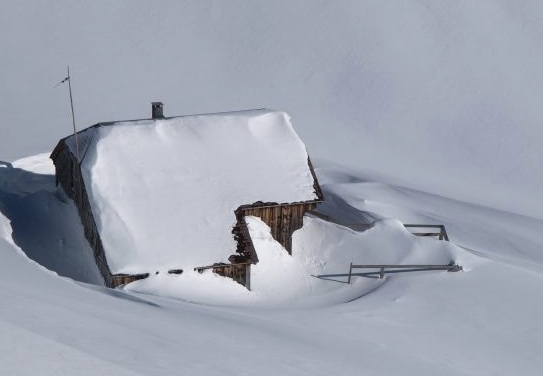

A Layer of Snow and a Layer of Silence
January 25 to March 8 2014
Eric Andersen, Hans Bellmer, Bruno Jakob, Ylva Ogland, Daniel de Roulet, Olympia Scarry, Andro Wekua
Organized by Gianni Jetzer
Blattistafel above Arnen Lake
Subfreezing temperatures, an ancient alpine hut in the middle of nowhere, a small dot in infinite whiteness, the group exhibition A Layer of Snow and a Layer of Silence is dedicated to the seclusion of alpine winter. Being an art show that is inaccessible, it triggers imagination.
A Layer of Snow and a Layer of Silence plays furthermore with the cliché of pure mountains, close to heaven and out of reach of the obliquity of human nature. The fiction is immediately annihilated by the proximity of Gstaad and its mundane clientele. Surprisingly the hut’s interior is tastefully renovated in modernist style. It is the snowed in hunting lodge of a famous collector.
The show echoes layers of the past, amplifies lost voices, and investigates secrets. The bolted door alludes to a nearby chalet, which played an important role in the life of Roman Polanski. The high mountains are countered by presumed innocence, seduction, and eventually detention. In between clean slate and blame game, canonization and damnation, the ethereal landscape bleaches out distinct perception.
The exhibition poster is hand printed by Eric Andersen as well as a map of the Milky Way. A vintage, hand-colored photograph entitled La Poupée by Hans Bellmer evocates broken dreams. A tear by Bruno Jakob on a Kleenex is pinned on the blanched façade of the hut, slowly sublimed by the weather. In a performance Ylva Ogland calls her twin Snöfrid (Peaceful Snow), who lives behind mirrors. Daniel de Roulet reads from his novel A Sunday in the Mountains. Olympia Scarry presents a work in Braille alphabet behind glass that thus remains undecipherable. Andro Wekua recalls the house he was born, now part of inaccessible territory on the Black Sea coast.
Special thanks to Friedrich Christian Flick, Maja Hoffmann, Barbara Gladstone, Miguel Abreu
The show is a contribution to Elevation1049, curated by Neville Wakefield and Olympia Scarry

Christian Marclay is a Swiss and American visual artist and composer. Marclay's work explores connections between sound, noise, photography, video, and film.
Valentin Carron, born in Martigny in 1977, lives and works in Fully. In recent years he has emerged with an oeuvre that combines central traditions of contemporary art making and questions them in terms of their current meaning. In this way he includes approaches to appropriation in his work as well as Pop Art traditions, the sociological search for clues and post-studio production. Valentin Carron is continuing the tradition of artists who, by means of appropriation and reproduction, offer a cultural analysis in their works.
Sylvie Fleury is a Swiss contemporary pop artist employing sculpture, mixed media. Her work addresses the issues of shopping, and the paradigm of the new age. Born 1961, Geneva.
Born in 1973, Urs Fischer began his career in Switzerland where he studied photography at the Schule fur Gestaltung, Zurich. He moved to Amsterdam in 1993 and had his first solo show at a gallery in Zurich, in 1996. Fischers subversive approach to art is often considered to be influenced by anti-art movements like Neo-Dada, Lost Art or the Situationist International. Since Fischer began showing his work, in the mid-nineteen-nineties, in Europe, he has produced an enormous number of objects, drawings, collages, and room-size installations.
Claudia Comte was born in Grancy in 1983, lives and works in Berlin.
Olaf Breuning (born 1970) is a Swiss-born artist who is currently living in New York.
John Armleder (born in Geneva in 1948) is a Swiss performance artist, painter, sculptor, critic, and curator. His work is based on his involvement with Fluxus in the 1960s and 1970s, when he created performance art pieces, installations and collective art activities that were strongly influenced by John Cage. However, Armleder's position throughout his career has been to avoid associating his artistic practice with any type of manifesto.
b. 1988 in Filderstadt (Germany); lives and works in Basel and Zurich, Swiss/USA
Born in 1948 in Sent, a village in the Lower Engadin region of Switzerland, Not Vital trained as an artist in both Paris and Rome. This marked the beginning of decades of travel, having bases as diverse as New York, USA; Cairo, Egypt; and Lucca, Italy, amongst many others.
Vital currently divides his time between studios in Sent; Beijing, China; Agadez, Niger; and Patagonia, Chile. Past and current projects include a sculpture park in his home village of Sent, a series of building sculptures in Agadez and the island of NotOna in Patagonia.
A lifetime of traversing the globe, constantly engaging with local cultures and makers, has made an indelible mark on his practice. An endless curiosity for engagement with new experiences, places and people remains at the heart of Vital's work.
Roman Signer (b. 1938 in Appenzell, Switzerland) is principally a visual artist who works in sculpture, installations photography, and video.
Signer started his career as an artist later in life at the age of 28, after working as an architect’s draughtsman, a radio engineer apprentice, and a short stint in a pressure cooker factory. He holds degrees from arts institutions in Switzerland and Poland. He studied at the Schule für Gestaltung in Zurich and Lucerne between 1966 and 1971. He studied at the Academy of Fine Arts in Warsaw, Poland from 1971-1972.
Olympia Scarry (born January 25, 1983 Geneva) is a Swiss artist, she lives and works in New York City. Her work traces mental and physical landscapes recorded through polygraph examinations, animal interactions and the human response to extreme or delicate situations. Scarry captures actions and reactions to moments of frustration and boredom and turns them into something tangible. Often Scarry's objects frustrate our expectations by rendering habitual urges impossible or by glorifying an involuntary response, creating involuntary drawings out of her pulse rate. Scarry looks to bring the audience and herself into conscious form. In creating environments and records of the human touch, Scarry voluntarily allows forms to overpower the physiology, one is inviting the other to lose themselves or rather find ones self again.
Kilian Rüthemann was born in St. Gallen in 1979. He studied stone sculpting at Zuzwil, St. Gallen (1997–2001) and Fine Arts and Media Art at Academy of Art and Design, Basel (2002–2005). Rüthemann makes sculptures using simple substances such as salt, sugar, bitumen or cement, interacting these with the fabric of the building that support them — the walls and floor of a gallery, its steps, windows and lighting, for instance — to form architectural interventions that alter the function of their known ingredients, allowing structural properties to expound their own logic.
Ugo Rondinone (born 1964 Brunnen, Switzerland) is a New-York based mixed-media artist whose works explore themes of fantasy and desire. Many of his pieces coax the viewer into a meditative state like the blurred, brightly colored, concentric rings of his target-shaped paintings; or his strictly black and white landscapes of gnarled trees that seem to bristle with energy.
Olivier Mosset was born 1944 in Bern, Switzerland and lives in Tucson, Arizona. For the last four decades, he has remained committed to questioning painting as a historical object by, somewhat paradoxically, continuing to paint. Through his affiliation with the B.M.P.T., a group of conceptually driven painters formed in Paris in the 1960s, Mosset and his peers—Daniel Buren, Michel Parmentier, and Niele Toroni (their initials reflected in their collective acronym)—sought to democratize art through radical procedures of deskilling. They also deftly deconstructed such modernist shibboleths as the primacy of authorship and the value of originality by signing each other’s works and repeating a specific compositional device across multiple grounds: while Buren became well-known for keeping to stripes, Mosset focused on the circle, which he painted in some two hundred iterations between 1966 and 1974.
Since that time, Mosset has turned to monochrome works on shaped canvases that more or less implicitly comment on circuits of production and exchange (stars standing in for revolutionary aspirations, or dollar signs representing, well, dollar signs). He has also explored other formats and materials of abstract painting involving more traditional oil and acrylic, as well as industrial plastic. Mosset alternately culls forms from the landscape as found abstractions and anchors paintings back to it, site- and architecturally specifically: He drew from the antitank traps dotting Europe’s roadsides for the Toblerones (1994–2007), massive yet ephemeral Minimalism-inspired sculptures produced in ice. His shimmering Golden Shower (2007) transformed the lowered garage door of SculptureCenter in Queens, New York, into an improbably beautiful wash of yellow paint.
Pipilotti Rist is a renowned Swiss artist who has pioneered the use of moving images in installation art.
Characterized by vibrant color, trance-like soundtracks, whimsy, and sensual appeal, Rist's art toes the line between fantasy and reality. She makes the commonplace seem unexpected and fascinating by taking familiar subjects, such as the body, and divorcing them from traditional representations.
Thomas Hirschhorn was born in Bern, Switzerland, in 1957. He studied at the Kunstgewerbeschule Zürich from 1978 to 1983. Over the past thirty years, Hirschhorn has become internationally renowned for his critically engaged and humanistic aesthetic. He has created over sixty works in public space that pair everyday materials with a universalizing approach that proposes that both the work of art and the process of artistic creation are collaborative and accessible to a broad ranging audience.
Bernhard Hegglin
Born 1989 in Zurich, Switzerland; lives and works in Zurich, Switzerland
Tina Braegger
Born 1985 in Zurich, Switzerland; lives and works in Zurich, Switzerland
Peter Fischli and David Weiss, often shortened to Fischli/Weiss, are an artist duo that have been collaborating since 1979. They are considered one of the worlds top contemporary artists.
Their best known work is the film “The Way Things Go” (Der Lauf der Dinge). This was described by The Guardian as being “Post Apocalyptic” as it is all about chain reactions and the way in which objects fly, crash, and explode across the studio it was shot in.
Fischli/Weiss have represented Switzerland at the Venice Biennale serveral times.
Artist David Weiss passed away on 27 April 2012 at age 65 in Zurich.
Gianni Jetzer is a curator and critic based in New York. He has realized numerous exhibitions with artists in his positions as curator at Migros Museum in Zurich (1998–2001), Director of Kunsthalle St. Gallen (2001–2006), and Director of Swiss Institute in New York (2006–2013). Since 2012 he is the curator of Unlimited, Art Basel's pioneering exhibition platform for projects that transcend the limitations of a classical art-show. Together with Chris Sharp he will in 2014 curate a large scale show entitled "Le Mouvement – Performing the City" taking place in Biel/Bienne. As a critic Jetzer has written many contributions for catalogues, art magazines, and newspapers such as Parkett, Flash Art, Spike, or Kaleidoscope.
Tobias Spichtig’s work is based on a discourse concerning images and their meaning—more specifically, the overwhelming presence of the media and the continuous availability of information, which contribute to the dissolution of time. His approach is based on material production. Concept and narration are abstracted and continually redefined. This creates symbolic works that present historical and contemporary as the bases of a radical presence.












































































